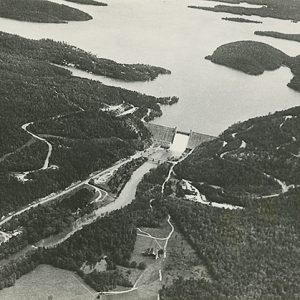calsfoundation@cals.org
Martin White Greeson (1866–1949)
Martin White Greeson was an attorney and civic activist who spent most of his adult life advocating for the construction of a dam on the Little Missouri River. He believed that such a structure was critical both to flood prevention and economic development. While he did not live to see his dream come to fruition, the dam was completed not long after his death. The resulting Lake Greeson was named in his honor.
Martin W. Greeson was born on November 7, 1866, in Clinton (Van Buren County). He was one of two children of Hartwell and Louisa Greeson, and he had two half-sisters from his father’s previous marriage.
He received his early education in the local schools, and he himself taught school in both Bee Branch (Van Buren County) and Morrilton (Conway County). He attended the Cumberland University Law School in Lebanon, Tennessee. Upon completing his studies, Greeson moved to Prescott (Nevada County) in 1888 and joined the law firm of Atkinson and Tompkins. Greeson married Carrie Cecelia Tedford on October 18, 1893, and they had four children: a son and three daughters. In 1900, he set up a law partnership with Henry B. McKenzie.
Greeson eventually stopped practicing law and instead turned his focus to business. At one point, he owned and operated the Murfreesboro-Nashville Southwest Railroad, an enterprise he maintained for a decade. Meanwhile, in 1913, he purchased Kimberlite Diamond Mining and Washing Company in Murfreesboro (Pike County). Deeply committed to the development of Prescott, he helped bring the Potlatch Corporation lumber company to the town and was instrumental in building the town’s first sanitarium.
Greeson began his effort to secure a dam at the narrows of the Little Missouri River in 1900, with his original goal being the prevention of the flooding that was such a common occurrence. After pushing the idea at the local level, he took it to the U.S. Congress in the 1920s, where it was repeatedly introduced and repeatedly forgotten. In an effort to facilitate the construction of both the dam and the flood control project, he had bought some of the land, but the idea remained on the drawing board. Appointed to the Arkansas Flood Control Commission by Governor Carl Bailey, Greeson continued to advocate for the idea until 1941, when Congress approved the Little Missouri River project and authorized $3 million for its implementation. However, the project was set aside during World War II, and construction did not begin until 1947.
Greeson died on November 16, 1949, in Prescott and is buried in De Ann Cemetery there. The flood control project—whose centerpiece was the 7,000-acre fishing lake created by the construction of the Narrows Dam on the Little Missouri River—was completed on July 12, 1951, and dedicated on July 21. In July 1952, Congress passed legislation to designate the lake created by the Narrows Dam as Greeson Lake in recognition of Greeson’s efforts.
For additional information:
“Martin White Greeson.” Nevada County Depot and Museum. http://www.depotmuseum.org/articles.php?article=23 (accessed November 18, 2020).
“Martin W. Greeson.” Nevada County Picayune. November 17, 1949, p. 1.
“Martin White Greeson.” Nevada County Picayune. November 14, 1949, p. 1.
William H. Pruden III
Ravenscroft School
 Business, Commerce, and Industry
Business, Commerce, and Industry Early Twentieth Century, 1901 through 1940
Early Twentieth Century, 1901 through 1940 Law
Law Narrows Dam Aerial View
Narrows Dam Aerial View 




Comments
No comments on this entry yet.